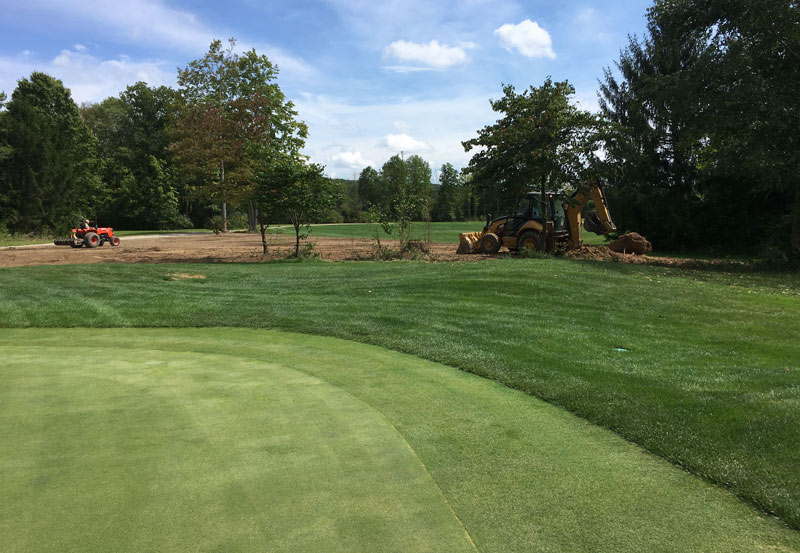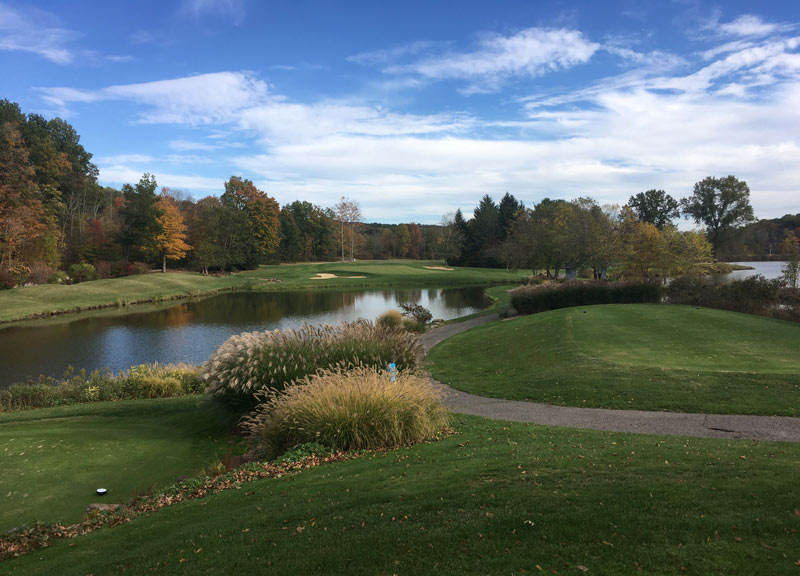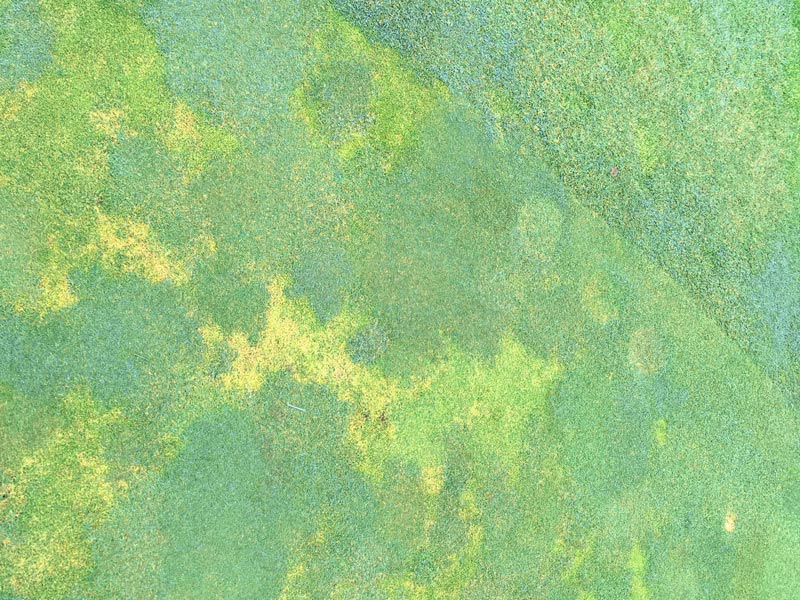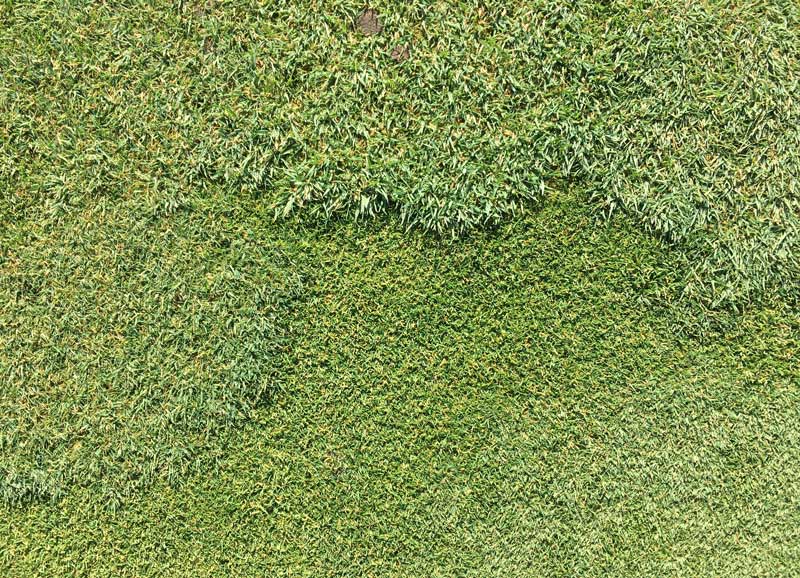
Crew members at The Sharon Golf Club in Sharon Center, Ohio, removed trees near the 12th green as part of a long-term program to increase the percentage of creeping bentgrass on putting surfaces. All-day full sun is critical in such a process, and, over a four-year period, the club was able to shift its average bentgrass cover from 50% to 85%. Photos by Frank Dobie
Throughout my 65 years on a golf course, I’ve frequently heard discussions regarding whether to manage Poa annua or to try to get rid of it. Because of numerous failures to eliminate Poa, we have succumbed to learning how to keep it alive all season.
Poa is a weak annual grass that requires higher costs to maintain and will die during the stresses of midsummer if conditions are not just right. In comparison, creeping bentgrass is more tolerant of summer stress and easier to manage. For the past 100 years or more, greenkeepers, superintendents, university professors, USGA agronomists and chemical companies have struggled with ways to eliminate Poa annua. To better understand why we want to replace Poa with bentgrass, we should first explain the nature of these grasses.
Poa annua is an annual bluegrass. It survives from year to year because it produces millions of seeds every spring that germinate in late summer. Poa is not hardy in the heat and humidity of midsummer, so it needs to be kept alive with light, frequent irrigation. Because of this life cycle, Poa annua resists most conventional efforts to eradicate it and successfully replace it with bentgrass. Thus, Poa has become the predominant grass on most northern golf courses.
Once a course has a sizable population of Poa, superintendents struggle to keep it alive through the golf season. Past attempts to chemically eliminate Poa annua and stop its fall regeneration have been disappointing. It loves the cool and moist conditions of fall and spring, so it flourishes and tends to overpower all other grasses during these times and under these conditions.
Poa annua vs. bentgrass: Reasons to transition
Poa annua’s disadvantages are:
- Its seedhead production for several weeks in late spring has an objectionable appearance and makes the putting surface bumpy.
- Its aggressive growth in spring crowds out bentgrass. It also outcompetes bentgrass in shady and wet conditions.
- Its summer root system is shallow (less than 1 inch) and dries out quickly, so it requires light, frequent irrigation to survive. Light, frequent irrigation builds up sodium and bicarbonates in the root zone, and these are detrimental to the plant.
- Because Poa tends to wilt in the afternoon heat, light watering is needed to keep it cool. This light, frequent watering also causes the surface (1/2 inch) to be mushy. Ball marks look like mini mud craters and are difficult to repair properly.
- In hot, dry soil conditions, Poa doesn’t go dormant like Kentucky bluegrass, fescue or bentgrass. It simply dies and will be replaced by the next generation of seeds in September.
- It is more susceptible to fungal diseases than bentgrass is, so it requires more frequent fungicide applications.
- It doesn’t hold up well under heavy foot or cart traffic in the summer heat.
The advantages of bentgrass are:
- It is a perennial and doesn’t produce a seedhead unless it is left unmowed.
- It has a deeper root system (3 to 5 inches) in the summer under good soil conditions.
- It can be watered deeply and infrequently (about 1 inch of water), which actually makes the surface drier than light, frequent watering and also prevents sodium and bicarbonates from building up in the root zone of porous soils.
- It is more resistant to fungal diseases compared with Poa annua.
- It withstands heat and traffic stress much better than Poa annua does.
- If it wilts and goes dormant under dry soil conditions, it can recover when moisture is provided.
Making the switch from Poa to creeping bentgrass
With the knowledge and tools of today, we can finally decrease Poa annua and increase bentgrass populations on greens, tees and fairways, and even achieve a total conversion to bentgrass. This conversion is relatively slow and can take several years to reach the desired population shift.
Shade, poor drainage and poor airflow have always been the reasons behind Poa annua’s rise to being the predominant grass on golf course greens, tees and fairways. For decades, superintendents and USGA agronomists have wanted to remove trees that shade the prime playing areas. Politics — not agronomy — is the main motivator blocking tree removal. A few vocal members who object to the removal of any tree tend to affect the decisions of the club. We all love trees for their beauty and function, but a tree in a specific place can be a detriment to a prime playing area like a green, tee or fairway. So tree removal becomes a choice for the club’s leaders.

A look at the 12th green at The Sharon Golf Club following a tree removal initiative that increased hours of sunlight — necessary in the switch from Poa to bentgrass.
There are many other valid reasons for tree removal, and I have detailed them in the article Reasons for golf course tree removal.
In recent years, some high-profile clubs have undertaken major tree removal, proving the value of no shade for better-quality playing surfaces. Most golf course architects now recognize that shade is a major factor in the decline of putting green quality and recommend selected tree removal. Memberships now accept that endorsement.
Keys to a successful Poa-to-bentgrass conversion
The environmental improvements of all-day full sun, excellent surface and subsurface drainage, and good airflow over the green’s surface are essential factors in the conversion of Poa annua to bentgrass. The final — and key — factor for this conversion is the use of plant growth regulators such as Trimmit and Cutless. These growth regulators stunt the Poa annua during its aggressive growth in spring and fall and promote aggressive growth of bentgrass, causing the population shift. For the growth regulators to be effective, it is essential that drainage deficiencies have been corrected and that trees that block airflow and produce morning and afternoon shade have been removed.
Here at The Sharon Golf Club in Sharon Center, Ohio, we shifted bentgrass populations on fairways from 50% to 95% in a four-year period.
The shift in population on greens has been slower than on fairways, but is still significant. During the same four-year period, we shifted the average from 50% bentgrass to 85%. Bentgrass populations on greens vary depending on how much shade is on the green. We also realized that the afternoon sunlight is just as important as the morning sun.

The use of plant growth regulators caused discoloration of Poa annua, a blight that golfers at The Sharon Golf Club were willing to overlook once informed of the reason for the yellowing.

The plant growth regulator Cutless stunted the Poa population and promoted lateral growth of bentgrass, causing a population shift.
The growth regulator Trimmit was used on fairways, and Cutless combined with Primo was used on greens. These growth regulators cause yellowing of the Poa annua, but that wasn’t an issue with our players when we explained to them the process and the goal.
Applications of Trimmit and Cutless are the final and critical step in a successful conversion. A number of other northern superintendents have had similar success with this method of Poa-to-bentgrass conversion.
Applications of Trimmit and Cutless will adversely affect the surrounding bluegrass rough if it receives overspray from the boom nozzles. We purchased a sprayer with GPS-guided individual nozzle controls to eliminate overlap spray.
I have learned there are no magic bullets in growing good turf, but there are a number of time-tested principles that, if followed, will give us a fighting chance. One of those principles is patience. In most cases, Mother Nature can’t be rushed, and that’s the case for superintendents seeking to replace their pesky Poa populations with preferable bentgrass.
Frank Dobie, a Penn State graduate, is a 61-year member of GCSAA and is the general manager and senior agronomist at The Sharon Golf Club in Sharon Center, Ohio. He was in charge of golf course construction at The Sharon Golf Club in 1964 and 1965, and was general manager/superintendent from 1964 to 2014. Dobie has been the president of the Musser International Turfgrass Foundation since 1988, and he received GCSAA’s Col. John Morley Distinguished Service Award in 2011.